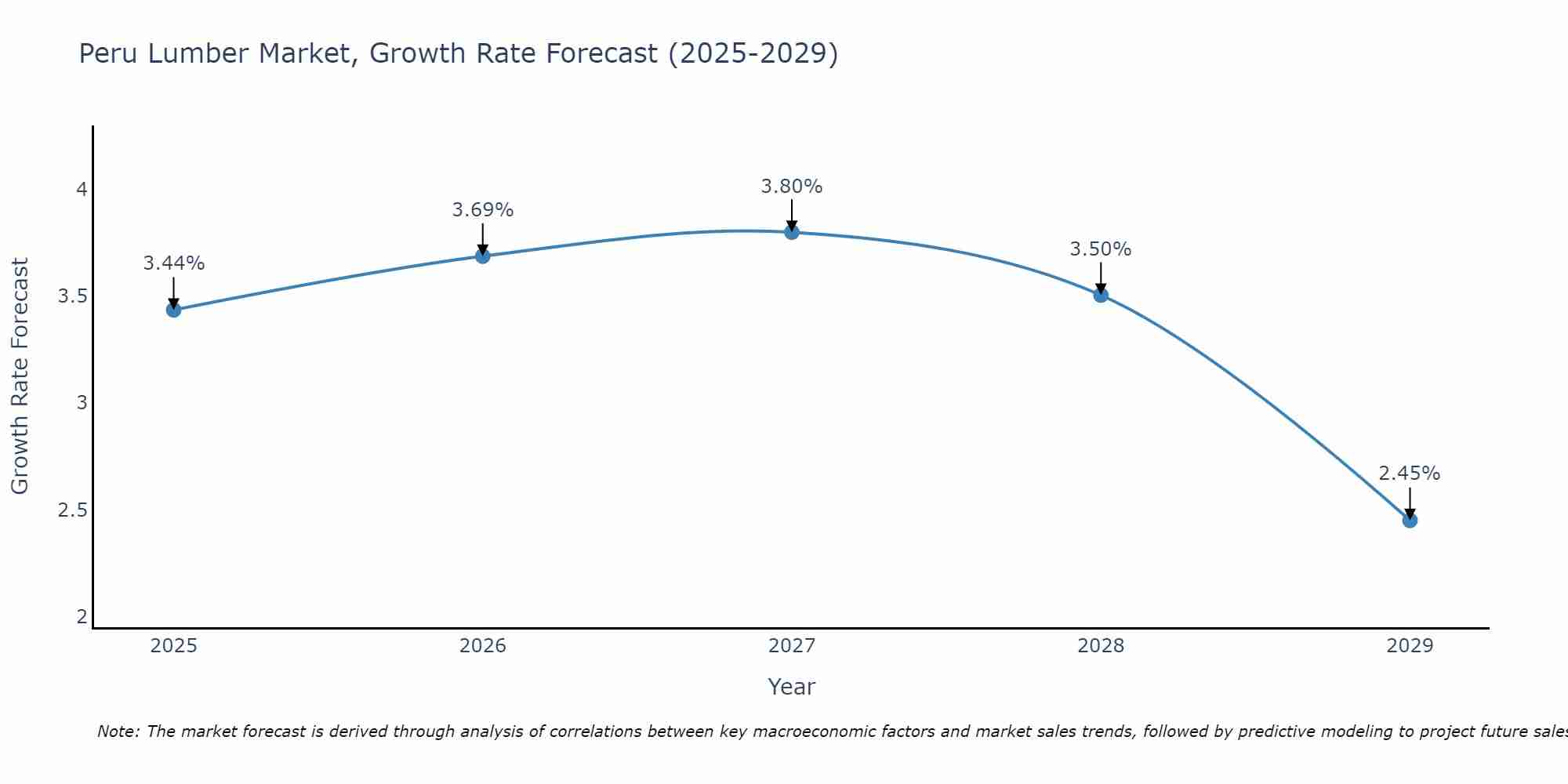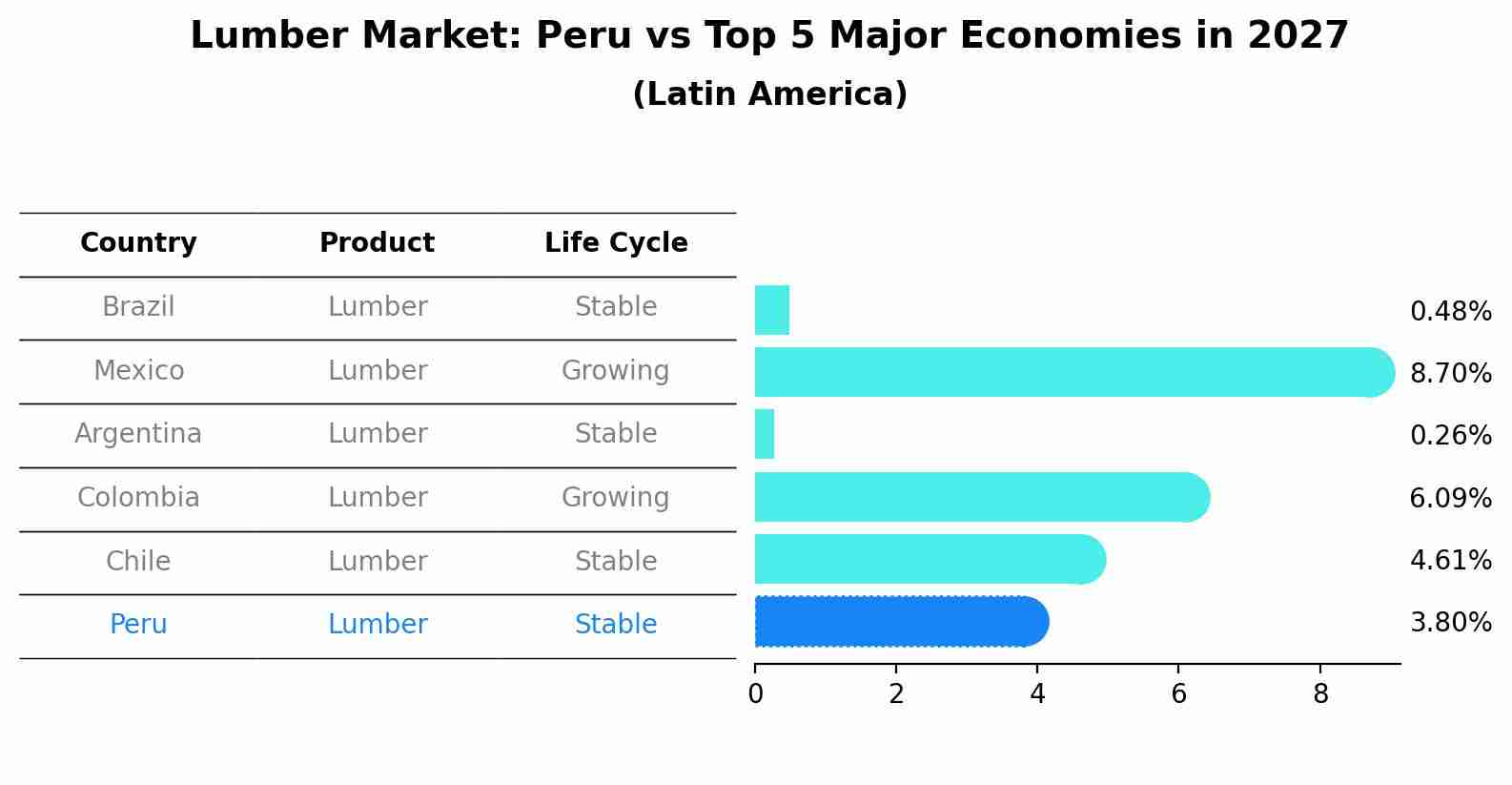Peru Lumber Market (2025-2031) | Value, Share, Size, Outlook, Revenue, Industry, Companies, Trends, Growth, Forecast & Analysis
| Product Code: ETC036746 | Publication Date: Oct 2020 | Updated Date: Jun 2025 | Product Type: Report | |
| Publisher: 6Wresearch | Author: Summon Dutta | No. of Pages: 70 | No. of Figures: 35 | No. of Tables: 5 |
Peru Lumber Market Size Growth Rate
The Peru Lumber Market is projected to witness mixed growth rate patterns during 2025 to 2029. The growth rate begins at 3.44% in 2025, climbs to a high of 3.80% in 2027, and moderates to 2.45% by 2029.

Lumber Market: Peru vs Top 5 Major Economies in 2027 (Latin America)
By 2027, Peru's Lumber market is forecasted to achieve a stable growth rate of 3.80%, with Brazil leading the Latin America region, followed by Mexico, Argentina, Colombia and Chile.

Peru Lumber Market Overview
The Peru lumber market is characterized by a growing demand for both domestic consumption and export markets. The country`s rich natural resources and diverse ecosystem make it a key player in the global timber industry. The market is primarily driven by construction activities, furniture manufacturing, and wood products for export. Sustainable forestry practices are gaining importance in Peru, with a focus on preserving the Amazon rainforest and promoting responsible logging practices. The government`s regulations and initiatives to promote sustainable forestry management have contributed to the market`s growth. Additionally, the increasing trend towards eco-friendly and certified wood products is shaping consumer preferences in the Peru lumber market. Overall, the Peru lumber market presents opportunities for both domestic suppliers and international investors looking to capitalize on the country`s abundant timber resources.
Peru Lumber Market Trends
Currently, the Peru lumber market is experiencing a trend towards sustainable and environmentally friendly practices. There is a growing demand for certified wood products from responsibly managed forests, driven by increasing awareness of deforestation and climate change issues. Consumers and businesses are seeking out timber that is sourced from sustainable sources, such as FSC-certified forests, to ensure the long-term health of ecosystems and support local communities. Additionally, there is a focus on promoting the use of alternative materials like bamboo and recycled wood products as a way to reduce the environmental impact of the construction and furniture industries. These trends indicate a shift towards more eco-conscious practices within the Peru lumber market.
Peru Lumber Market Challenges
The Peru lumber market faces several challenges, including illegal logging practices that contribute to deforestation and environmental degradation. Limited enforcement of regulations and weak governance structures make it difficult to control the illegal timber trade. Additionally, the lack of sustainable forest management practices hinders the long-term viability of the industry. Market volatility and fluctuations in global demand also pose challenges for lumber producers in Peru. Addressing these issues requires a multi-faceted approach that involves improving regulatory frameworks, increasing transparency in the supply chain, promoting sustainable logging practices, and fostering partnerships between the government, industry stakeholders, and local communities to ensure the responsible and sustainable management of Peru`s forests.
Peru Lumber Market Investment Opportunities
Investment opportunities in the Peru lumber market are promising due to increasing demand for wood products driven by construction and infrastructure development projects. With Peru being a major exporter of timber, investing in timber companies or timberland can provide opportunities for long-term growth. Additionally, sustainable forestry practices and certifications are becoming more important globally, creating opportunities for investments in environmentally responsible timber companies in Peru. Investing in the Peru lumber market also offers diversification benefits, as the country`s timber industry is relatively underdeveloped compared to other markets. However, investors should consider factors such as regulatory changes, market volatility, and potential environmental risks when evaluating investment opportunities in the Peru lumber market.
Peru Lumber Market Government Policy
The Peru government has implemented various policies related to the lumber market to promote sustainable forestry practices and combat illegal logging. These policies include the Forest and Wildlife Law, which regulates the extraction and commercialization of forest resources, and the National Forestry and Wildlife System, which aims to monitor and control activities in the sector. Additionally, Peru has entered into international agreements such as the Forest Law Enforcement, Governance, and Trade (FLEGT) Action Plan with the European Union to ensure legal and sustainable timber trade. The government also enforces strict penalties for illegal logging activities and promotes the certification of sustainably managed forests through programs like the Forest Stewardship Council (FSC). These policies aim to protect Peru`s valuable forests, biodiversity, and indigenous communities while promoting responsible and legal timber production.
Peru Lumber Market Future Outlook
The future outlook for the Peru lumber market appears positive due to increasing demand driven by infrastructure development and construction projects within the country. The government`s focus on promoting sustainable forestry practices and the expansion of the housing sector are expected to further boost demand for lumber in Peru. Additionally, the growing trend towards eco-friendly and renewable building materials is likely to drive the demand for certified sustainable wood products. However, challenges such as illegal logging and regulatory constraints may pose risks to the market`s growth potential. Overall, with the right policies and initiatives in place to address these challenges, the Peru lumber market is poised for steady growth in the coming years.
Key Highlights of the Report:
- Peru Lumber Market Outlook
- Market Size of Peru Lumber Market, 2024
- Forecast of Peru Lumber Market, 2026
- Historical Data and Forecast of Peru Lumber Revenues & Volume for the Period 2021 - 2031
- Peru Lumber Market Trend Evolution
- Peru Lumber Market Drivers and Challenges
- Peru Lumber Price Trends
- Peru Lumber Porter's Five Forces
- Peru Lumber Industry Life Cycle
- Historical Data and Forecast of Peru Lumber Market Revenues & Volume By Types for the Period 2021 - 2031
- Historical Data and Forecast of Peru Lumber Market Revenues & Volume By Hardwood Lumber for the Period 2021 - 2031
- Historical Data and Forecast of Peru Lumber Market Revenues & Volume By Softwood Lumber for the Period 2021 - 2031
- Historical Data and Forecast of Peru Lumber Market Revenues & Volume By Application for the Period 2021 - 2031
- Historical Data and Forecast of Peru Lumber Market Revenues & Volume By Construction for the Period 2021 - 2031
- Historical Data and Forecast of Peru Lumber Market Revenues & Volume By Furniture for the Period 2021 - 2031
- Historical Data and Forecast of Peru Lumber Market Revenues & Volume By Flooring for the Period 2021 - 2031
- Historical Data and Forecast of Peru Lumber Market Revenues & Volume By Moldings for the Period 2021 - 2031
- Historical Data and Forecast of Peru Lumber Market Revenues & Volume By Others for the Period 2021 - 2031
- Peru Lumber Import Export Trade Statistics
- Market Opportunity Assessment By Types
- Market Opportunity Assessment By Application
- Peru Lumber Top Companies Market Share
- Peru Lumber Competitive Benchmarking By Technical and Operational Parameters
- Peru Lumber Company Profiles
- Peru Lumber Key Strategic Recommendations
Frequently Asked Questions About the Market Study (FAQs):
1 Executive Summary |
2 Introduction |
2.1 Key Highlights of the Report |
2.2 Report Description |
2.3 Market Scope & Segmentation |
2.4 Research Methodology |
2.5 Assumptions |
3 Peru Lumber Market Overview |
3.1 Peru Country Macro Economic Indicators |
3.2 Peru Lumber Market Revenues & Volume, 2019 & 2026F |
3.3 Peru Lumber Market - Industry Life Cycle |
3.4 Peru Lumber Market - Porter's Five Forces |
3.5 Peru Lumber Market Revenues & Volume Share, By Types, 2019 & 2026F |
3.6 Peru Lumber Market Revenues & Volume Share, By Application, 2019 & 2026F |
4 Peru Lumber Market Dynamics |
4.1 Impact Analysis |
4.2 Market Drivers |
4.3 Market Restraints |
5 Peru Lumber Market Trends |
6 Peru Lumber Market, By Types |
6.1 Peru Lumber Market, By Types |
6.1.1 Overview and Analysis |
6.1.2 Peru Lumber Market Revenues & Volume, By Types, 2016 - 2026F |
6.1.3 Peru Lumber Market Revenues & Volume, By Hardwood Lumber, 2016 - 2026F |
6.1.4 Peru Lumber Market Revenues & Volume, By Softwood Lumber, 2016 - 2026F |
6.2 Peru Lumber Market, By Application |
6.2.1 Overview and Analysis |
6.2.2 Peru Lumber Market Revenues & Volume, By Construction, 2016 - 2026F |
6.2.3 Peru Lumber Market Revenues & Volume, By Furniture, 2016 - 2026F |
6.2.4 Peru Lumber Market Revenues & Volume, By Flooring, 2016 - 2026F |
6.2.5 Peru Lumber Market Revenues & Volume, By Moldings, 2016 - 2026F |
6.2.6 Peru Lumber Market Revenues & Volume, By Others, 2016 - 2026F |
7 Peru Lumber Market Import-Export Trade Statistics |
7.1 Peru Lumber Market Export to Major Countries |
7.2 Peru Lumber Market Imports from Major Countries |
8 Peru Lumber Market Key Performance Indicators |
9 Peru Lumber Market - Opportunity Assessment |
9.1 Peru Lumber Market Opportunity Assessment, By Types, 2019 & 2026F |
9.2 Peru Lumber Market Opportunity Assessment, By Application, 2019 & 2026F |
10 Peru Lumber Market - Competitive Landscape |
10.1 Peru Lumber Market Revenue Share, By Companies, 2024 |
10.2 Peru Lumber Market Competitive Benchmarking, By Operating and Technical Parameters |
11 Company Profiles |
12 Recommendations |
13 Disclaimer |
- Single User License$ 1,995
- Department License$ 2,400
- Site License$ 3,120
- Global License$ 3,795
Search
Thought Leadership and Analyst Meet
Our Clients
Related Reports
- Afghanistan Apparel Market (2026-2032) | Growth, Outlook, Industry, Segmentation, Forecast, Size, Companies, Trends, Value, Share, Analysis & Revenue
- Canada Oil and Gas Market (2026-2032) | Share, Segmentation, Value, Industry, Trends, Forecast, Analysis, Size & Revenue, Growth, Competitive Landscape, Outlook, Companies
- Germany Breakfast Food Market (2026-2032) | Industry, Share, Growth, Size, Companies, Value, Analysis, Revenue, Trends, Forecast & Outlook
- Australia Briquette Market (2025-2031) | Growth, Size, Revenue, Forecast, Analysis, Trends, Value, Share, Industry & Companies
- Vietnam System Integrator Market (2025-2031) | Size, Companies, Analysis, Industry, Value, Forecast, Growth, Trends, Revenue & Share
- ASEAN and Thailand Brain Health Supplements Market (2025-2031) | Strategy, Consumer Insights, Analysis, Investment Trends, Opportunities, Growth, Size, Share, Industry, Revenue, Segments, Value, Segmentation, Supply, Forecast, Restraints, Outlook, Competition, Drivers, Trends, Demand, Pricing Analysis, Competitive, Strategic Insights, Companies, Challenges
- ASEAN Bearings Market (2025-2031) | Strategy, Consumer Insights, Analysis, Investment Trends, Opportunities, Growth, Size, Share, Industry, Revenue, Segments, Value, Segmentation, Supply, Forecast, Restraints, Outlook, Competition, Drivers, Trends, Demand, Pricing Analysis, Competitive, Strategic Insights, Companies, Challenges
- Europe Flooring Market (2025-2031) | Outlook, Share, Industry, Trends, Forecast, Companies, Revenue, Size, Analysis, Growth & Value
- Saudi Arabia Manlift Market (2025-2031) | Outlook, Size, Growth, Trends, Companies, Industry, Revenue, Value, Share, Forecast & Analysis
- Uganda Excavator, Crane, and Wheel Loaders Market (2025-2031) | Strategy, Consumer Insights, Analysis, Investment Trends, Opportunities, Growth, Size, Share, Industry, Revenue, Segments, Value, Segmentation, Supply, Forecast, Restraints, Outlook, Competition, Drivers, Trends, Demand, Pricing Analysis, Competitive, Strategic Insights, Companies, Challenges
Industry Events and Analyst Meet
Whitepaper
- Middle East & Africa Commercial Security Market Click here to view more.
- Middle East & Africa Fire Safety Systems & Equipment Market Click here to view more.
- GCC Drone Market Click here to view more.
- Middle East Lighting Fixture Market Click here to view more.
- GCC Physical & Perimeter Security Market Click here to view more.
6WResearch In News
- Doha a strategic location for EV manufacturing hub: IPA Qatar
- Demand for luxury TVs surging in the GCC, says Samsung
- Empowering Growth: The Thriving Journey of Bangladesh’s Cable Industry
- Demand for luxury TVs surging in the GCC, says Samsung
- Video call with a traditional healer? Once unthinkable, it’s now common in South Africa
- Intelligent Buildings To Smooth GCC’s Path To Net Zero


















